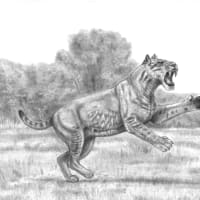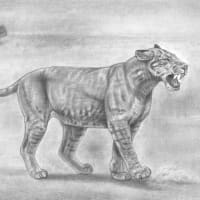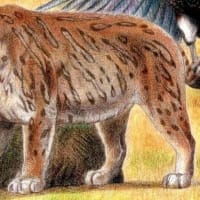
The Columbian Mammoth !


GFSマストドン復元画と対になる作品です。まだ制作途上であり、画質、背景ディテールなどよりクオリティーを上げていきますので、完成版もどうぞチェックしてみてください。
©the Saber Panther (all rights reserved)
<遺伝子、形態双方の最新の分析手法による北米マンモスの分類見直し>
近年のターゲットシークエンス解析技術の急速な進展に伴い、困難とされた温帯域や断片化の著しい更新世動物のDNA情報の効率的な解析が、実現化してきているようです。新しい解析技術を駆使して、パレオロクソドン属ストレートタスクゾウや北米コロンビアマンモスなど、温帯域の絶滅長鼻類の遺伝情報の解読発表が相次いだことは、記憶に新しいところです(このブログでも縷々触れてきました)。
2016年にはEnk et al. がローレンタイド氷床以南の地域に分布していた北米マンモス群、具体的にはウーリーマンモス(Mammuthus primigenius)とコロンビアマンモス(Mammuthus columbi)、コロンビアマンモスの形態型ヴァリアントとされるピグミーマンモス(Mammuthus exilis)とジェファソンマンモス(Mammuthus jeffersoni)各標本から、67の全ミトコンドリアゲノム配列の解析に成功し、研究成果を公にしました(Enk et al. 'Mammuthus Population Dynamics in Late Pleistocene North America: Divergence, Phylogeography, and Introgression' 2016)。
それによると、ローレンタイド氷床以南に分布していたウーリーマンモスとコロンビアマンモスなど北米に固有のマンモス群は女系祖先を共有し、これら北米マンモス群(上記ウーリーマンモスを含む)のミトコンドリアDNAの配列は、アジア産とヨーロッパ産のウーリーマンモス間に確認されているよりも、近似していることが分かったそうです。
遺伝的近縁性は複数種に分けられてきた北米マンモス群に共通の特徴であることが明らかになりました。
遺伝的近縁性は複数種に分けられてきた北米マンモス群に共通の特徴であることが明らかになりました。
この事態を説明する鍵となるのは遺伝子移入(introgression)であり、著者らは北米マンモス群の間で大規模な異種間交配が起こっていたという見解を示しています。
少なくとも段階的に二度の大規模な異種交配が起こっていたと考えられ、一度目はシベリアから移動してきたウーリーマンモスと北米先住のマンモス群との間に起こり、いま一つは、ローレンタイド氷床以南に南下したウーリーマンモスと先住のコロンビアマンモスとの間に交配が起こっていたというのです。
Widga et al. (Enk教授も共同執筆に名を連ねる)が2017年に発表した北米マンモス群の歯形形態の分析(Widga et al. 'Reconciling phylogenetic and morphological trends in North American Mammuthus' 2017)においても、分子系統学上の上記仮説と同調する興味深い結果が出ています。
ウィスコンシン氷期に氷床以南の北米各地に分布したマンモス群を対象に、かつてない大規模なサンプル数の上顎第三大臼歯の形態学的分析が実施されました。
結論だけを述べると、北米マンモス群の大臼歯形態には、遺伝子ハプログループの分布の仕方と良く適合する形で、地域別に変異性(variabilty)が認められますが、それは短期間に各地環境への適応などの条件下で生じた変異性であり、種レヴェルの差異の程度を示すものではないということです。
要するに、遺伝子、形態双方の最新の分析手法が、ウィスコンシン氷期の氷床以南の北米に存在したマンモスは単独一種であるという、同じ仮説を示唆するに至っているということ。地域的、時間的な形質変異が生じても、遺伝子型にはほとんど変化が認められないということでしょう。
化石長鼻類分類の黎明期、Osbornは北米マンモスに3属16種もあったと主張していたそうです。その数は分類分析手法の進展に伴い劇的に縮小し、近年の分類では1属4種(M. columbi, M. primigenius, M. exilis, M. jeffersoni)ないし2種(M. columbi, M. primigenius(ピグミーマンモスとジェファソンマンモスをコロンビアマンモスの形態型ヴァリアントとみなす場合)に落ち着いていたことはご存知だと思いますが、今や1種のみとする仮説が信憑性を帯びているのですから、驚いてしまいます。
しかしながら、上記のいずれの著者も頭蓋ー歯形にみられる変異性の生態形態学的見地からの重要性など鑑みて、従来的な分類の有効性を完全に否定するには至っておらず、さらなるサンプル、さらに高度な分析手法(その筆頭に挙げられるのは、核DNAシークエンシング)を用いた化石長鼻類分類見直しの必要を、改めて喚起してもいるのです。
なお、この復元画の舞台は更新世後期の北米南東部であり、生息していたのはいわゆる「コロンビアマンモス (M. columbi)」ですが、この地域からは特にウーリーマンモスとの共通の形質要素を色濃くもつ個体が出ているそうで(Widga, 2018 私信)、かつてジェファソンマンモスとして区別された個体群も、Midcontinentから南東部にかけて集中的に分布していました。
This is a scene from upper-Pleistocene southeast North America, a home to a number of significant megafauna during the Ice Age, including the great Columbian(/Jeffersonian) mammoth depicted here. This picture is an accompanying piece to the upcoming GFS matodon restoration. The finished version will be higher resolutioned and much more fully rendered.
Some mammoth specimens inhabited Midcontinent through to southeast showed morphological trends intermediate between those of woolly mammoths and columbian mammoths, more distinctively so than in specimens of other regions, and thus sometimes being given its unique specific status : the Jeffersonian mammoth.
-Background concept-
New genetic and morphological approaches used to re-determine North American mammoth taxonomy
Recent technological advances in targeted enrichment sequencing method now allows scientists for the first time, efficient sequencing of the heavily fragmented DNA from Pleistocene specimens found in low latitude, thermolabile contexts.
Using this innovative technology, Enk et al. (2016) succeeded in sequencing 67 complete mitochondrial genomes from North American mammoths that lived south of the Laurentide ice sheet. The research shows that mitochondrial genomes of mammoths throughout the Midwest, Great Plains, Great Basin and West Coast show relatively minor phylogeographic differences, suggesting all temperate North American mammoths share a common matriline. Moreover, two columbian mammoth specimens were found to be mitochondrially more closely related to North American woolly mammoths than woolly
mammoths from different continents were to each other.
New genetic datasets present good evidence that these instances of woolly-columbian mitogenomic affinity was typical rather than exceptional. The authors believe at least two distinct stages of extensive interbreeding between conventional 'species' are likely responsible for this genetic pattern: one between Siberian woolly mammoths and resident American populations and another between ecomorphologically distinct woolly and columbian mammoths in North America south of the ice.
New morphological analysis by Widga et al. (2017) focusing on analysing upper third permanent molars of North American mammoth specimens from across the continent also came to the conclusion that's consistent with these genetic data: there is broad agreement in the geographic distribution of genetic haplotypes and molar morphology but regional variability in mammoth dental morphology was not significantly distinct (in light of degree of hypsodonty and molar shape) and was likely the result of relatively recent selective pressures in certain environments or the genetic history of population expansion.
In a nutshell, genetic and morphological datasets for North American mammoths now indicate a single, although morphologically variable, population south of the Laurentide ice sheet during the Wisconsin glaciation. Both authors however, still don't entirely disagree with the traditional taxonomic groupings(M. columbi, M. primigenius, M. exilis, M. jeffersoni) since they can be useful indicators of potentially important ecomorphological variability.
Further investigations of genetic and morphological trends in Mammuthus will be necessary.
イラスト&テキスト by ©the Saber Panther (all rights reserved)



















※コメント投稿者のブログIDはブログ作成者のみに通知されます